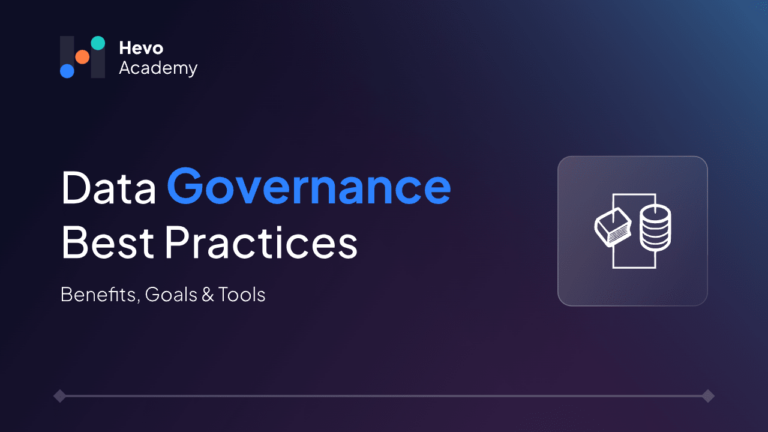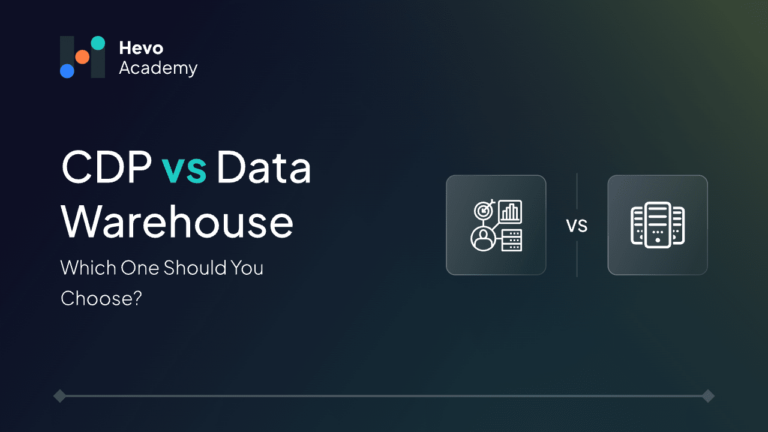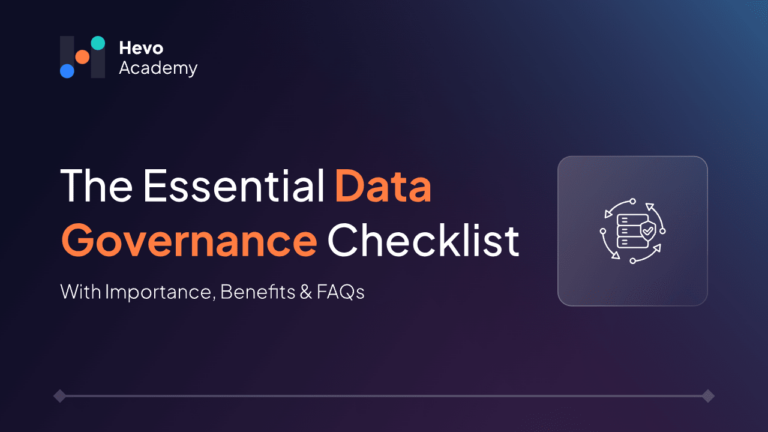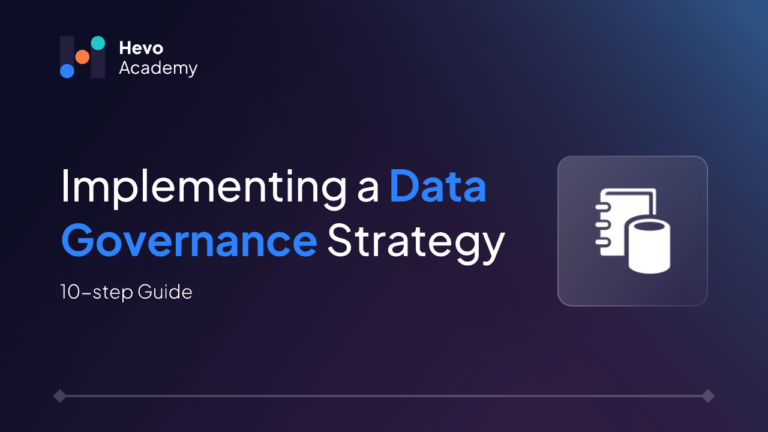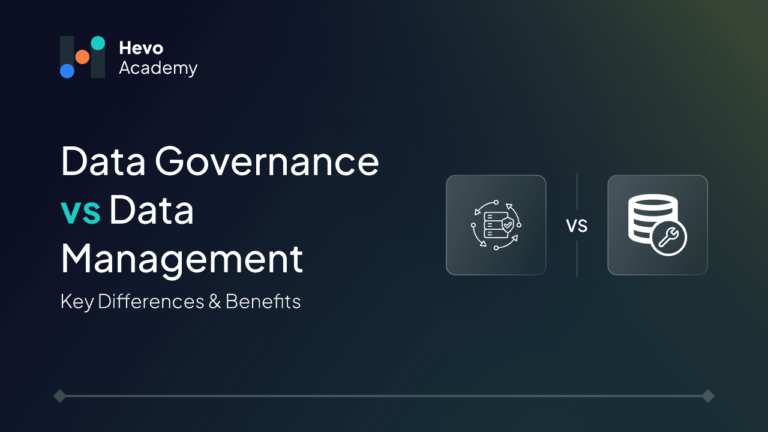Data is an important asset for any organization; therefore, the importance of data governance cannot be ignored. Data governance ensures that the data being used complies with regulations. Effective data governance is essential to maintaining data security, quality, and integrity. Without data governance, data inconsistencies will arise in every organization. This article discusses some of the data governance best practices that can help organizations implement efficient frameworks and practices to manage their data effectively.
Table of Contents
What is Data Governance?
Data governance is the management of data throughout its life cycle to ensure that it is high-quality, trustworthy, and compliant with regulations. To reduce risks and avoid legal issues, data governance focuses on prioritizing legal and regulatory compliance.
Effective data governance is crucial for maintaining data quality, security, and compliance. With Hevo, you can:
- Ensure consistent data governance across 150+ data sources
- Automate data integration workflows while maintaining compliance
- Gain full visibility into data lineage for better control and auditing
- Simplify governance with real-time data updates and synchronization
See why companies like Postman and Plentific trust Hevo to streamline data integration and ensure regulatory compliance. Unlock smarter data management with Hevo today!
Get Started with Hevo for FreeData Governance Best Practices
1. Start with a Clear Purpos
Set clear and detailed goals that align with the organization’s strategic objectives. These objectives provide a purpose and direction for the governance of data initiatives and ensure that all resources are used efficiently. Senior leadership must also provide resources, authority, and dedication.
2. Embrace a Data-Driven Mindset
Protect data from security breaches and unauthorized access. Implement necessary security measures, including access control, authentication, and encryption. Ensure that all sensitive information is protected from any breach and comply with data protection regulations.
3. Craft Your Data Roadmap
After assessing an organization’s current data management situation, create a data governance strategy. Examine current data processes and problems to identify where improvements are required. Ensure that the data framework addresses all essential data management challenges and is implemented efficiently.
4. Leverage the Right Technology for Governance
To maintain good data quality, implement various methods for data cleansing, validation, and monitoring. Use metrics to measure and track data’s completeness, consistency, and correctness.
5. Build Your Data A-Team
Form a committee dedicated to data governance with members from IT, compliance, and business groups. The group should be in charge of overseeing and carrying out data governance programs. It is also recommended to define the committee’s roles, responsibilities, and decision-making authority, including roles for data owners, data engineers, and data stewards who manage data quality and follow policies.
6. Set the Ground Rules
Create data policies that address multiple areas of data management, such as usage, access, quality, and retention. These guidelines ensure that all practices adhere to legal standards by outlining how data is gathered, stored, exchanged, and disposed of. They establish explicit guidelines for data management throughout the organization. Data policies are also used to define data standards. Data standards serve to improve data dependability and reduce discrepancies.
7. Standardize and Document Every Process
Create and document specific processes and procedures for managing data governance operations, such as data collection, integration, quality control, monitoring, and problem resolution. Documenting these processes ensures that they are consistently followed across the organization.
Benefits of Data Governance
- Data governance enhances data reliability, consistency, and accuracy. When data quality management processes are implemented, organizations can ensure that the data being used is free from discrepancies and errors.
- Adherence to data security and protection regulations is essential to avoid legal complications and secure confidential data. These rules prioritize concepts such as transparency, accountability, and individual rights, requiring organizations to obtain explicit consent for data processing and report data breaches.
- Data governance helps to use data resources effectively and also improves an organization’s productivity. An effective data governance framework streamlines data management processes and reduces redundancy.
Goals of Data Governance
- Data governance helps reduce risks associated with data management, including security breaches, non-compliance, and inaccuracies.
- Ensuring compliance and following legal regulations are key goals for data governance. Organizations should implement policies and practices to comply with laws and avoid legal issues.
- One key goal of data governance is to enhance data quality, ensuring that the data is consistent, complete, and clean.
- Data governance ensures that the data is reliable and accurate. It helps in making a strong foundation for making informed and strategic decisions.
- Data governance helps optimize data management processes to reduce redundancy and improve efficiency.
Data Governance Framework
The data governance framework combines the various components of data governance. It is a set of rules, processes, policies, and roles that decide how an organization collects, stores, organizes, and uses data.
- Data Governance Policies: These are formal rules and guidelines that govern the data management practices within organizations to ensure the data is managed in compliance with the law. They define who can access data and under what conditions. They are guidelines for how data can be used and handled. The data retention period is defined here.
- Data Governance Processes: These are workflows and procedures that define how data governance activities are managed to provide an organized and clear approach. They include procedures for resolving and addressing data-related discrepancies and issues and managing changes in data processes, systems, or policies.
- Data Governance Roles: These include clearly defined duties and roles for individuals involved to ensure accountability for data management tasks. There are several roles, including data owners who are accountable for the overall management of datasets and their quality; data stewards who are responsible for implementing data governance policies and quality; data custodians who manage data storage and infrastructure, ensuring data security; and some other roles.
Steps to Implement a Data Governance Framework
- Establish clear, precise goals that align with the organization’s strategic objectives. These objectives provide data governance initiatives with a focus and direction, ensuring that resources are used effectively.
- Develop a data governance strategy after reviewing an organization’s current state of data management. Review existing data practices and challenges to understand where improvements are needed.
- Create a data governance committee responsible for implementing and managing data governance initiatives. Define the committee’s roles, responsibilities, and decision-making authority.
- Data policies must be developed to cover various aspects of data management, including usage, access, quality, and retention. These policies ensure that all practices comply with legal requirements by addressing how data is collected, stored, shared, and disposed of.
- Define and document detailed processes and procedures for managing data governance activities such as data collection, integration, quality, monitoring, and issue resolution.
- Deploy data governance tools that support various aspects of data governance, such as quality monitoring, data cataloging, and lineage tracking.
- Create various training programs to educate employees about data governance processes, policies, and tools. The training should be tailored according to the different roles within the organization. Each group should understand its specific responsibilities and how to comply with governance practices.
- Perform regular audits and reviews to ensure that data governance policies and regulations are being followed. Implement mechanisms to keep track of the performance of data governance practices using metrics and key performance indicators (KPIs).
- Gather feedback from users and stakeholders regarding the effectiveness of the governance framework. This feedback can highlight where changes or improvements might be required. Based on this feedback and the need for changes, update the data governance policies, processes, and tools as needed.
Data Governance Tools
A range of solutions are available with distinct features and functionalities to address different facets of data governance, ranging from quality control and cataloging to security and legal compliance. Here are a few of these tools:
Comparison of Tools
| Tool | Description | Data Governance Best Practices Supported |
| Collibra | Collibra provides user-friendly data governance and cataloging solutions with features for business glossary management and data privacy. It supports collaboration across teams. | Supports policy development and enforcement, data quality management, and security and privacy considerations. |
| Alation | Alation is known for its robust data cataloging with an intuitive interface. It facilitates data stewardship, data lineage tracking, and quality maintenance. | Enhances data quality management, policy enforcement, and supports data stewardship and traceability. |
| Microsoft Purview | Microsoft Purview integrates with Azure and other data platforms, offering comprehensive data cataloging, lineage tracking, and compliance features. | Supports data cataloging, lineage tracking, and compliance with data privacy regulations. |
| IBM Watson Knowledge Catalog | IBM Watson Knowledge Catalog integrates with IBM’s data and AI solutions, offering metadata management, data lineage, and AI-driven insights for data quality. | Facilitates data quality management, metadata management, and policy enforcement. |
| SAP Data Intelligence | SAP Data Intelligence provides data integration, orchestration, and cataloging, with capabilities for metadata management and lineage tracing. | Supports data integration, metadata management, and visibility into data flows for improved governance. |
| DataRobot | DataRobot offers machine learning and AI capabilities, with tools for model lifecycle management, data stewardship, and integration with data sources. | Supports data quality management, governance of machine learning models, and data stewardship. |
| Google Cloud Data Catalog | Google Cloud Data Catalog is a fully managed service for metadata management and data discovery within Google Cloud. | Supports metadata management, data discovery, and integration with other cloud services. |
| AWS Glue | AWS Glue is a serverless data integration tool with ETL capabilities and data cataloging. It offers centralized metadata management and integrates with AWS services. | Facilitates metadata management, data integration, and automated ETL processes for streamlined data governance. |
Take a look at the Best Data Governance Tools which you can use in further detail to choose the right tool for your organization.
Conclusion
Data governance ensures that data management procedures adhere to standards and regulatory obligations. Effective data governance procedures must be implemented to manage data assets, guarantee compliance, and facilitate well-informed decision-making. By following best practices and leveraging the right tools, organizations can establish a strong data governance framework that enhances data quality, security, and usability. Data governance identifies how data is handled and protects the sensitive information. Data governance helps organizations maximize the value of their data while mitigating risks and ensuring regulatory compliance.
Sign up for a 14-day free trial and simplify your data integration process. Check out the pricing details to understand which plan fulfills all your business needs.
FAQs
1. What is the best practice for data governance?
The best practices for data governance include managing data quality, ensuring privacy and security, assigning roles and developing clear policies.
2. What are the strong data governance strategies?
Some of the strong data governance strategies include defining clear and concise objectives, developing comprehensive policies, implementing effective tools, and establishing a culture of data stewardship.
3. What are the four key functional areas of data governance?
The four key functional areas of data governance are data management, data quality, data compliance and data security.
4. What is data governance in a nutshell?
Data governance involves defining roles and complying with policies and procedures to manage data quality, availability, integrity, and security.

